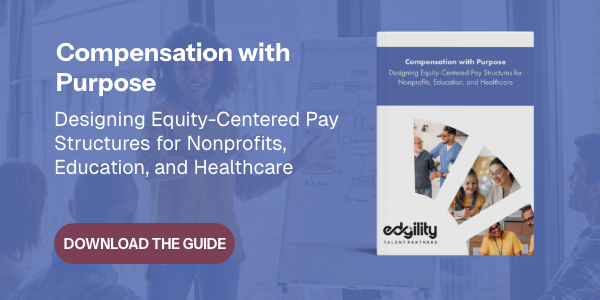You want to do right by your team—but right now, your compensation program is raising more questions than it answers.
Staff are talking. Some feel undervalued, others suspect pay decisions aren’t fair. There’s confusion, frustration, and a growing sense that whoever advocates for themselves the loudest wins. You’re stuck in reactive mode, trying to patch gaps in your employee compensation approach, responding to individual pay requests, and maintaining peace.
And you’re not alone. We’ve worked with numerous nonprofits, philanthropic organizations, and educational institutions that are navigating this same landscape: committed to pay equity, but hindered by outdated systems, inconsistent compensation practices, and a lack of internal capacity.
Here’s the good news: A thoughtfully executed compensation plan design—one that integrates staff input and aligns with your business goals—can rebuild trust and create organizational alignment. But it takes more than just publishing base salary ranges. It starts with a compensation strategy centered on clarity, consistency, and care.
Table of Contents
1. WHY TRANSPARENCY MATTERS MORE THAN EVER
2. WHY ORGANIZATIONS HESITATE—AND WHY YOU SHOULDN’T LET THAT STOP YOU
3. STEP 1: BUILD YOUR COMPENSATION PHILOSOPHY BEFORE YOU BUILD YOUR STRUCTURE
4. STEP 2: ASSESS HOW COMPETITIVE YOU REALLY ARE
5. STEP 3: BUILD A STRUCTURE THAT REFLECTS YOUR VALUES—AND YOUR REALITY
6. STEP 4: PLACE YOUR TEAM MEMBERS ON THE STRUCTURE—FAIRLY AND TRANSPARENTLY
7. STEP 5: COMMUNICATE WITH COURAGE (AND A PLAN)
8. STEP 6: MAINTAIN IT LIKE YOU MEAN IT
9. BUILD WHAT YOU CAN STAND BEHIND
Why Transparency Matters More Than Ever
Pay transparency laws are gaining momentum across the U.S., but compliance is just the beginning. Your people are already talking about their pay—whether or not you’ve created the space for it. The real question is: Are you leading the narrative or letting speculation fill the gaps?
When pay structures are hidden or unclear, unproductive behavior like gossip, fear, and perceived inequity takes root. In the absence of transparent compensation practices, employees often rely on fragmented information, such as Glassdoor threads, peer whispers, and assumptions. Trust, morale, and team cohesion begin to erode.
By contrast, a compensation program grounded in shared principles and clear performance metrics offers:
-
Clarity on base pay, incentive compensation, and salary progression
-
Alignment across departments on how compensation decisions are made
-
Reduced pressure on HR teams to respond to ad hoc pay requests
Transparent pay practices lead to a culture of predictability, accountability, and fairness. They allow employees to focus on performance, not politics. It sets a healthy tone across the organization: “We do things on purpose, and we do them together.”
Why Organizations Hesitate—and Why You Shouldn’t Let That Stop You
Many equity-driven leaders hesitate to go transparent. Common concerns include:
“We don’t have a compensation plan.”
Without salary structures or benchmarks, there’s nothing to share. That’s a real issue, but it’s also the starting point for change.
“We have a plan, but we don’t understand it.”
Perhaps the compensation design is outdated, or your HR team isn’t equipped to explain the rationale behind it. That’s an opportunity to build understanding—not a reason to delay.
“We’re far below market and can’t afford to fix it.”
Chances are, your staff already know. What they want is transparency and a roadmap to fair pay—including timelines, milestones, and accountability.
Effective compensation management isn’t about perfection. It’s about ownership, communication, and a long-term strategy that aligns with both financial realities and organizational values.
Step 1: Build Your Compensation Philosophy Before You Build Your Structure
Transparency begins with clarity. That means starting with a compensation philosophy. We guide organizations through a process that includes:
-
Setting a market target. Will you anchor compensation around the 50th percentile? 60th? 75th? Let your talent strategy be your guide.
-
Clarifying what you reward. Tenure? High-performing staff? Certifications? Collaboration? Define what matters to your organization.
-
Determining decision-making authority. Will compensation decisions be centralized within Human Resources or delegated to department leaders?
-
Balancing pay and employee benefits. This is a core aspect of compensation plan design. How are you allocating resources across base salary, professional development, health insurance, and retirement benefits? How does your approach to total rewards support both staff retention and organizational needs?
-
Aligning with values. If pay equity, inclusion, or shared leadership are central to your mission, your incentive plans and bonus structures should reinforce those commitments.
We recommend co-creating your compensation philosophy with staff. Input gathered through employee surveys, design sessions, and feedback loops creates the foundation for trust, clarity, and shared accountability. Once your philosophy is documented and aligned across leadership, you’re ready to build a structure that reflects it.
Step 2: Assess How Competitive You Really Are
With your philosophy in place, the next step is to understand how your compensation plan aligns with current labor market trends.
Use a multi-source benchmarking approach that includes:
-
At least three recent salary surveys (within 1–2 years)
-
Employer-reported compensation data from reputable sources
-
Adjustments for inflation and cost-of-labor trends
-
Comparisons to the right market: same sector, similar org size, and geographic considerations
Don’t rely solely on job titles alone. Instead, use structured comparisons based on:
-
Years of experience
-
Management scope and budget authority
-
Required credentials or certifications
-
Organizational impact and job descriptions
This benchmarking process ensures apples-to-apples comparisons and reveals where your current pay rates sit relative to market conditions. It helps identify gaps in your employee compensation approach based on real responsibilities—not inflated titles.
Step 3: Build a Structure That Reflects Your Values—and Your Reality
Once you know your position in the labor market, you can develop a compensation structure aligned with your compensation strategy.
Start by defining salary grades with minimum, midpoint, and maximum pay rates–group similar roles based on scope, level, and contribution. Use wider ranges for executives (to allow for tenure growth) and tighter ranges for early-career roles.
But here’s the nuance: Market rates aren’t neutral and usually undervalue certain functions (e.g., HR or direct service roles vs. tech and development roles). A well-thought-out compensation plan design provides an opportunity to challenge those norms and incorporate pay equity into your structure.
Consider internal equity, gender pay gaps, and the historical under-compensation of people-centered roles. Your compensation design should support fairness, retention, and alignment with organizational goals.
Step 4: Place Your Team Members on the Structure—Fairly and Transparently
This is where your compensation philosophy comes into operation.
Evaluate each employee against your structure:
-
Who is aligned with their salary grade?
-
Who is below (and needs to move closer to the midpoint)?
-
Who is above (and may require a creative solution)?
For those below, develop a multi-year catch-up plan. Offer additional annual increases or targeted raises until base pay is aligned.
For those above: Don’t cut pay—but consider temporarily freezing salary or offering modest increases below market movement. You can also use performance bonuses (non-compounding) to reward strong work without widening the gap.
The key is consistency. Develop a plan, apply it universally, and explain it clearly. By using performance metrics and incentive plans to guide compensation decisions, you reinforce fairness, drive engagement, and reduce guesswork—all increasing the buy-in you will receive.
Step 5: Communicate With Courage (and a Plan)
Even the most equitable compensation program will fall short without the right kind of intentional communication.
We recommend a phased rollout:
-
Train your whole executive team first, and provide FAQ documents
-
Train managers second, and give them reference materials
-
Finally, roll out to staff—with a consistent message and time for 1:1 conversations
Equip managers to confidently answer, ‘What does this mean for me?’ for each person on their team.
Then embed compensation conversations into your people systems:
-
New hire onboarding
-
Annual salary planning
-
Performance management cycles
Treat transparency not as a one-time event but as a continuous dialogue rooted in your values and objectives.
Step 6: Maintain It Like You Mean It
Compensation plan design isn’t a set-it-and-forget-it exercise. It’s a living part of your total rewards strategy.
Keep it current:
-
Update salary ranges annually to reflect market changes.
-
Refresh benchmarks every 2–3 years.
-
Reassess the entire plan after major organizational shifts, such as mergers, restructuring, or rapid growth.
Use compensation data to streamline your approach and automate updates wherever possible. That allows HR and leadership teams to stay focused on strategic business needs and team engagement.
Remember: Your structure should always reflect the organization you are, not the one you used to be.
Build A Compensation Plan You Can Stand Behind
A compensation plan should reflect your values, support your company goals, and serve your people. It can’t just look fair on paper—it must feel fair in practice.
If you’ve never built a compensation structure before, don’t go it alone. Just like remodeling your home, some projects require the neutral perspective and expertise of a professional.
At Edgility, we help mission-driven organizations design compensation plans that are equitable, financially sustainable, and aligned with the communities they serve. From compensation design to rollout, we bring the structure, insight, and partnership to move from confusion to clarity.
Because compensation isn’t just about pay—it’s about trust.
Ready to Take Your Compensation Plan Further?
Your people deserve pay systems that are clear, fair, and aligned with your mission. Get the proven framework in our free eBook, Compensation with Purpose: Designing Equity-Centered Pay Structures for Nonprofits, Education, and Healthcare.





